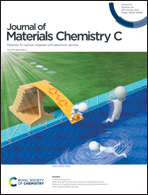Laser-controlled projection of quantum dot dipoles using metal-oxide plasmonic metastructures: maintaining spin polarization memory†
Abstract
It is known that the spontaneous emission of semiconductor quantum dots is mostly unpolarized when they are excited off-resonantly. The complete loss of polarization memory is associated with the ultrafast carrier scattering, leading to complete spin polarization relaxation. We study the application of metal-oxide plasmonic double-junction structures to transfer the excitation polarization memory of quantum dots to their spontaneous emission. These structures consist of arrays of metallic nanoantennas in the presence of heterostructures consisting of Au/Si Schottky junctions and Si/Al-oxide charge barriers. Our results show that by using such double-junction structures, one can control the states of polarization and intensity of the emission of quantum dots using the state of polarization of an off-resonant laser field. For achieving this, we explore the optical control of exciton–plasmon coupling using optical lattice modes caused by the arrays of metallic nanoantennas, and the application of the electrostatic field generated by the hot electrons captured at the Au/Si Schottky junction.



 Please wait while we load your content...
Please wait while we load your content...
